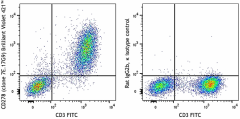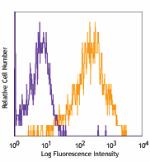- Clone
- 7E.17G9 (See other available formats)
- Regulatory Status
- RUO
- Other Names
- Inducible COStimulatory molecule, H4
- Isotype
- Rat IgG2b, κ

-

ConA-stimulated (3 days) C57BL/6 splenocytes were stained with anti-mouse CD3 (clone 17A2) FITC and anti-mouse CD278 (ICOS) (clone 7E.17G9) Brilliant Violet 421™ (left) or rat IgG2b, κ Brilliant Violet 421™ isotype control (right).
| Cat # | Size | Price | Quantity Check Availability | ||
|---|---|---|---|---|---|
| 117429 | 50 µg | $250.00 | |||
The 7E.17G9 antibody reacts with the 47-57 kD ICOS protein, also known as inducible costimulatory molecule, and H4. This protein is homologous to the CD28/CTLA-4 proteins. ICOS is expressed on activated T cells and a subset of thymocytes and can costimulate T cells and induce proliferation. In addition ICOS has been shown to be involved in humoral immune responses (B cell germinal center formation). The ICOS ligand, B7h/B7RP-1 and B7-H2 is constitutively expressed in B cell areas of secondary lymphoid organs and can be induced in other tissues by LPS. ICOS stimulation has been shown to potentiate TCR-mediated IL-4 and IL-10 production and has been proposed to play a role in Th2 cell development. ICOS stimulation has been shown to be involved in airway tolerance and the downregulation of pulmonary inflammation.
Product Details
- Verified Reactivity
- Mouse
- Antibody Type
- Monoclonal
- Host Species
- Rat
- Immunogen
- Mouse ICOS cDNA and ICOS hexahistidine fusion protein
- Formulation
- Phosphate-buffered solution, pH 7.2, containing 0.09% sodium azide and BSA (origin USA)
- Preparation
- The antibody was purified by affinity chromatography and conjugated with Brilliant Violet 421™ under optimal conditions.
- Concentration
- 0.2 mg/mL
- Storage & Handling
- The antibody solution should be stored undiluted between 2°C and 8°C, and protected from prolonged exposure to light. Do not freeze.
- Application
-
FC - Quality tested
- Recommended Usage
-
Each lot of this antibody is quality control tested by immunofluorescent staining with flow cytometric analysis. For flow cytometric staining, the suggested use of this reagent is ≤ 0.5 µg per million cells in 100 µL volume. It is recommended that the reagent be titrated for optimal performance for each application.
Brilliant Violet 421™ excites at 405 nm and emits at 421 nm. The standard bandpass filter 450/50 nm is recommended for detection. Brilliant Violet 421™ is a trademark of Sirigen Group Ltd.
Learn more about Brilliant Violet™.
This product is subject to proprietary rights of Sirigen Inc. and is made and sold under license from Sirigen Inc. The purchase of this product conveys to the buyer a non-transferable right to use the purchased product for research purposes only. This product may not be resold or incorporated in any manner into another product for resale. Any use for therapeutics or diagnostics is strictly prohibited. This product is covered by U.S. Patent(s), pending patent applications and foreign equivalents. - Excitation Laser
-
Violet Laser (405 nm)
- Application Notes
-
Additional reported applications (for the relevant formats) include: blocking of ligand binding. The LEAF™ format is suggested for blocking studies.
-
Application References
(PubMed link indicates BioLegend citation) -
- Akbari O, et al. 2002. Nat. Med. 8:1024.
- Harada H, et al. 2003. J. Clin. Invest. 112:234.
- McAdam AJ, et al. 2000. J. Immunol. 165:5035. (FC Block)
- Tan SL, et al. 2006. J. Immunol. 176:2872. PubMed
- RRID
-
AB_3097389 (BioLegend Cat. No. 117429)
Antigen Details
- Structure
- CD28/CTLA-4, 47-57kD
- Distribution
-
Activated T cells, subset of thymocytes
- Function
- Costimulates T cell activation, proliferation, humoral immune response
- Ligand/Receptor
- B7h/B7RP-1/GL-50
- Cell Type
- T cells, Thymocytes
- Biology Area
- Costimulatory Molecules, Immunology
- Molecular Family
- CD Molecules
- Antigen References
-
1. Rudd CE, et al. 2003. Nat. Rev. Immunol. 3:544.
2. McAdam AJ, et al. 2000. J. Immunol. 165:5035.
3. Mak TW, et al. 2003. Nat. Immunol. 4:765 - Gene ID
- 54167 View all products for this Gene ID
- UniProt
- View information about CD278 on UniProt.org
Other Formats
View All CD278 Reagents Request Custom Conjugation| Description | Clone | Applications |
|---|---|---|
| Biotin anti-mouse CD278 (ICOS) | 7E.17G9 | FC |
| PE anti-mouse CD278 (ICOS) | 7E.17G9 | FC |
| TotalSeq™-A0847 anti-mouse CD278 (ICOS) | 7E.17G9 | PG |
| TotalSeq™-C0847 anti-mouse CD278 (ICOS) | 7E.17G9 | PG |
| Ultra-LEAF™ Purified anti-mouse CD278 (ICOS) | 7E.17G9 | FC,Block |
| PE/Cyanine7 anti-mouse CD278 (ICOS) | 7E.17G9 | FC |
| PerCP/Cyanine5.5 anti-mouse CD278 (ICOS) | 7E.17G9 | FC |
| APC anti-mouse CD278 (ICOS) | 7E.17G9 | FC |
| TotalSeq™-B0847 anti-mouse CD278 (ICOS) | 7E.17G9 | PG |
| Spark Red™ 718 anti-mouse CD278 (ICOS) | 7E.17G9 | FC |
| Brilliant Violet 421™ anti-mouse CD278 (ICOS) | 7E.17G9 | FC |
| Brilliant Violet 711™ anti-mouse CD278 (ICOS) | 7E.17G9 | FC |
Compare Data Across All Formats
This data display is provided for general comparisons between formats.
Your actual data may vary due to variations in samples, target cells, instruments and their settings, staining conditions, and other factors.
If you need assistance with selecting the best format contact our expert technical support team.
-
Biotin anti-mouse CD278 (ICOS)

Con A-stimulated (3 days) Balb/c splenocytes stained with bi... -
PE anti-mouse CD278 (ICOS)

Con A-stimulated (3 days) C57BL/6 splenocytes stained with 7... -
TotalSeq™-A0847 anti-mouse CD278 (ICOS)
-
TotalSeq™-C0847 anti-mouse CD278 (ICOS)
-
Ultra-LEAF™ Purified anti-mouse CD278 (ICOS)
-
PE/Cyanine7 anti-mouse CD278 (ICOS)

ConA-stimulated (3 days) C57BL/6 splenocytes were stained wi... -
PerCP/Cyanine5.5 anti-mouse CD278 (ICOS)

ConA-stimulated (3 days) C57BL/6 splenocytes were stained wi... -
APC anti-mouse CD278 (ICOS)

ConA-stimulated (3 days) C57BL/6 splenocytes were stained wi... -
TotalSeq™-B0847 anti-mouse CD278 (ICOS)
-
Spark Red™ 718 anti-mouse CD278 (ICOS)

ConA-stimulated (3 days) BALB/c splenocytes were stained wit... -
Brilliant Violet 421™ anti-mouse CD278 (ICOS)

ConA-stimulated (3 days) C57BL/6 splenocytes were stained wi... -
Brilliant Violet 711™ anti-mouse CD278 (ICOS)

ConA-stimulated (3 days) C57BL/6 splenocytes were stained wi...
